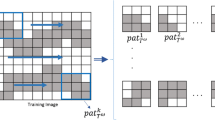Abstract
Abundant literature has been produced for the last two decades about multiple-point statistics simulation, or MPS. The idea behind MPS is very simple: reproduce patterns from a 2D, or most often a 3D, training image that displays the type of geological heterogeneity deemed to be relevant to the reservoir or field under study, while honoring local data. Replicating an image is a traditional computer science problem. Thus, it should come as no surprise if a growing number of publications on MPS borrow ideas and techniques directly from computer vision and machine learning to improve the reproduction of training patterns. However, quoting Andre Journel, “Geostatistics is not about generating pretty pictures.” Models have a purpose. For example, in oil and gas applications, reservoir models are used to estimate hydrocarbon volumes and book reserves, run flow simulations to forecast hydrocarbon production and ultimate recovery, and make decisions about field development or optimal well drilling locations. Specific key features such as the extent and connectivity of shale barriers may have a major impact on the reservoir performance forecasts and the field development decisions to be made. Those key features that need to be captured in the model, along with the available subsurface data and constraints of the project, should be the primary drivers in selecting the most appropriate modeling techniques and options to obtain reliable results and make sound decisions. In this paper, the practitioners’ point of view is used to evaluate alternative MPS implementations and highlight remaining gaps.


Similar content being viewed by others
References
Arpat B, Caers J (2007) Stochastic simulation with patterns. Math Geol 39:177–203
Boisvert J, Pyrcz M, Deutsch C (2007) Multiple-point statistics for training image selection. Nat Resour Res 16(4):313–321
Caumon G, Strebelle S, Caers J, Journel A (2004) Assessment of global uncertainty for early appraisal of hydrocarbon fields. SPE paper 89943
Chugunova TL, Hu LY (2008) Multiple-point simulations constrained by continuous auxiliary data. Math Geosci 40:133–146
Daly C (2004) Higher order models using entropy, Markov random fields and sequential simulation. In: Leuangthong O, Deutsch C (eds) Proceeding of the 2004 international geostatistics congress. Springer, Banff, pp 215–224
Deutsch C (1992) Annealing Techniques Applied to Reservoir Modeling and the Integration of Geological and Engineering (Well Test) Data. Dissertation, Stanford University
Deutsch C, Journel A (1998) GSLIB: geostatistical software library and user’s guide, 2nd edn. Oxford University Press, Oxford
Deutsch C, Tran T (2002) FLUVSIM: a program for object-based stochastic modeling of fluvial depositional systems. Comput Geosci 28(4):525–535
Emery X, Lantuéjoul C (2014) Can a training image be a substitute for a random field model? Math Geosci 46(2):133–147
Farmer C (1992) Numerical rocks. In: King P (ed) The mathematical generation of reservoir geology. Clarendon Press, Oxford
Gloaguen E, Dimitrakopoulos R (2009) Two-dimensional conditional simulations based on the wavelet decomposition of training images. Math Geosci 41:679–701
Goovaerts P (1997) Geostatistics for natural resources evaluation. Oxford University Press, Oxford
Guardiano F, Srivastava M (1993) Multivariate geostatistics: beyond bivariate moments. In: Soares (ed) Geostatistics-Troia. Kluwer Academic, Dordrecht, pp 133–144
Haas A, Formery P (2002) Uncertainties in facies proportion estimation I. Theoretical framework: the Dirichlet distribution. Math Geol 34:679–702
Hadavand M, Deutsch C (2017) Facies proportion uncertainty in presence of a trend. J Pet Sci Eng 153:59–69
Harding A, Strebelle S, Levy M, Thorne J, Xie D, Leigh S, Preece R, Scamman R (2004) Reservoir facies modeling: new advances in MPS. In: Leuangthong O, Deutsch C (eds) Proceeding of the 2004 international geostatistics congress. Springer, Banff, pp 559–568
Journel A (2002) Combining knowledge from diverse sources: an alternative to traditional data independence hypotheses. Math Geol 34:573–594
Journel A (2004) Beyond covariance: the advent of multiple-point geostatistics. In: Leuangthong O, Deutsch C (eds) Proceeding of the 2004 international geostatistics congress. Springer, Banff, pp 225–233
Journel A, Alabert F (1989) Non-Gaussian data expansion in the earth sciences. Terra Nova 1:123–134
Laloy E, Herault R, Jacques D, Linde N (2018) Training-image based geostatistical inversion using a spatial generative adversarial neural network. Water Resour Res 54(1):381–406
Srivastava M (2018) The origins of the multiple-point statistics (MPS) algorithm. In: Sagar, Cheng and Agterberg (eds) Handbook of mathematical geosciences. Springer, pp 652–672
Strebelle S (2000) Sequential simulation drawing structures from training images. Dissertation, Stanford University
Strebelle S, Cavelius C (2014) Solving speed and memory issues in multiple-point statistics simulation program SNESIM. Math Geosci 46:171–186
Strebelle S, Remy N (2004) Post-processing of multiple-point geostatistical models to improve reproduction of training patterns. In: Leuangthong O, Deutsch C (eds) Proceeding of the 2004 international geostatistics congress. Springer, Banff, pp 979–988
Strebelle S, Zhang T (2004) Non-stationary multiple-point geostatistical models. In: Leuangthong O, Deutsch C (eds) Proceeding of the 2004 international geostatistics congress. Springer, Banff, pp 235–244
Tahmasebi P (2017) Structural adjustment for accurate conditioning in large-scale subsurface systems. Adv Water Resour 101:60–74
Willis B, Sun T (2019) Relating depositional processes of river-dominated deltas to reservoir behavior using computational stratigraphy. J Sediment Res 89:1250–1276
Wu J, Zhang T, Journel A (2008) A fast FILTERSIM simulation with score-based distance. Math Geosci 40:773–788
Zhang T, Switzer P, Journel A (2006) Filter-based classification of training image patterns for spatial simulation. Math Geol 38:63–80
Author information
Authors and Affiliations
Corresponding author
Rights and permissions
About this article
Cite this article
Strebelle, S. Multiple-Point Statistics Simulation Models: Pretty Pictures or Decision-Making Tools?. Math Geosci 53, 267–278 (2021). https://doi.org/10.1007/s11004-020-09908-8
Received:
Accepted:
Published:
Issue Date:
DOI: https://doi.org/10.1007/s11004-020-09908-8




